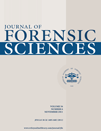Comparisons of Familial DNA Database Searching Strategies
Abstract
Abstract: The current familial searching strategies are generally based on either Identity-By-State (IBS) (i.e., number of shared alleles) or likelihood ratio (i.e., kinship index [KI]) assessments. In this study, the expected IBS match probabilities given relationships and the logic of the likelihood ratio method were addressed. Further, the false-positive and false-negative rates of the strategies were compared analytically or by simulations using Caucasian population data of the 13 CODIS Short Tandem Repeat (STR). IBS ≥ 15, IBS ≥ 16, KI ≥ 1000, or KI ≥ 10,000 were found to be good thresholds for balancing false-positive and false-negative rates. IBS ≥ 17 and/or KI ≥ 1,000,000 can exclude the majority of candidate profiles in the database, either related or not, and may be an initial screening option if a small candidate list is desired. Polices combining both IBS and KI can provide higher accuracy. Typing additional STRs can provide better searching performance, and lineage markers can be extremely useful for reducing false rates.




